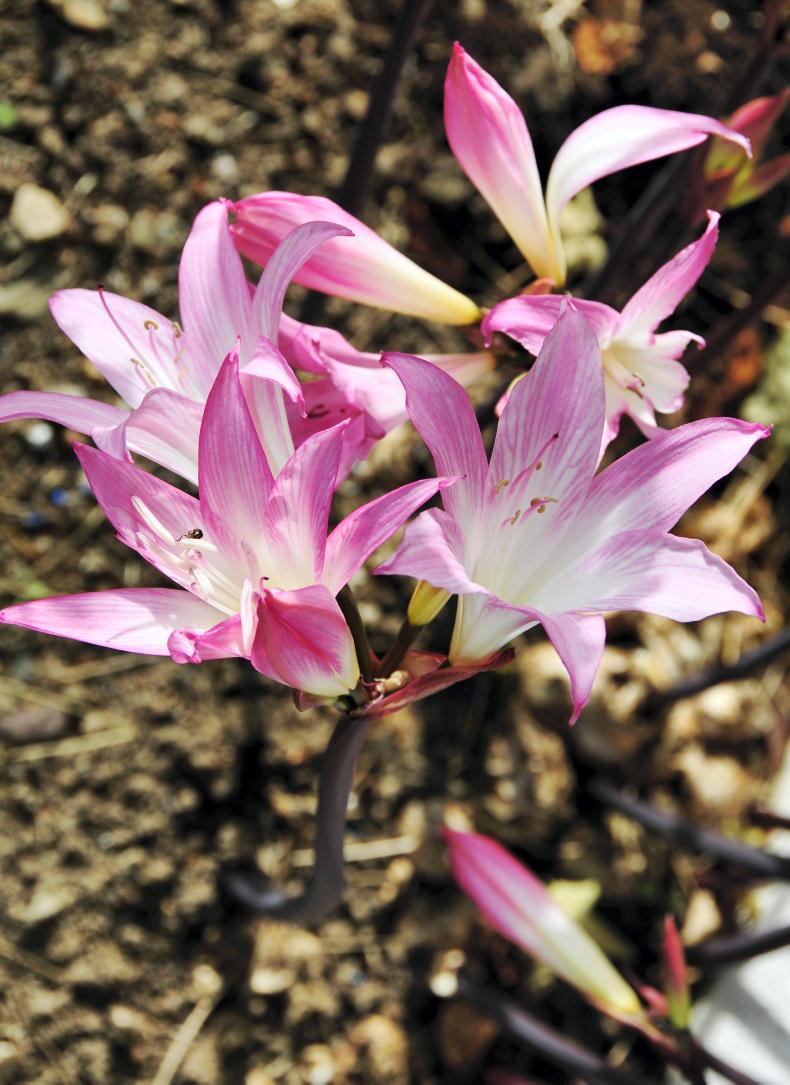The Jersey lily has a knack of appearing in a few days. One week there is no sign of it – no leaves and no flower stems – and a week later it is in flower, creating a lovely surprise.
It seems that the bulbs from which the flowers appear lie dormant in the soil, the leaves having withered away in early summer, until the weather in autumn gets a bit cooler and rain percolates down around the bulbs. Once flowering is triggered, between mid-September and mid-October, it happens very fast.
In just a few days, the flower stem emerges from the bulb and elongates rapidly, with the group of flower buds held in a pointed tip. The flower stems are a deep purplish wine colour. As the stems grow, the flower buds swell in size and are ready to open when the flower stem reaches about 40cm.
The protective membrane around the flower buds splits and the flowers open, first one and then a couple more. Each flower stem can carry three to seven or eight flowers. The flowers are of a narrow trumpet-shape. They open when still growing, starting out very pale pink – almost white down in the trumpet and flushed more deeply pink at the tips of the six petals.
As they mature, the petals reflex backwards to some degree. This gives the flowers a lively, flared appearance and a freshness that contrasts with the general air of decline in the autumn garden. The flowers are sweetly scented.
As the flowers age in sequence, the older ones take on a darker pink hue before they wither and fall – but there is a sequence of opening that extends the show of flower for two or three weeks. The usual kind is pale pink but there are some selections like ‘Cape Town’ which is rosy pink and ‘Hathor’ which is white.
The Jersey is also known as the true amaryllis and its correct botanical name is Amaryllis belladonna. The plant is native to South Africa, not to Jersey as the common name suggests, but it grows well in Jersey’s mild climate. The name is often confusing because it was formerly applied to the related hippeastrum from South America, and the name is still often used for hippeastrum. This confusion probably reduces familiarity with the true amaryllis. Amaryllis was a beautiful nymph in Greek mythology, and ‘belladonna’ means beautiful woman in Italian.
While this lovely flower is not easy to come by, it is sometimes available in garden centres that stock a good selection of flower bulbs. The bulbs are the size of a large onion – round and almost flat on top. The bulbs are planted so that the top of the bulb is just at soil level. If the bulbs get crowded, they may push up a little. They are best planted at the base of a wall, south-facing where the bulbs are baked in summer sun and well-drained soil at all times.
The soil should not be very rich and some gravel or grit can be dug in to give perfect drainage. The strappy foliage is produced after flowering and grows in spring, withering away in summer. Snails can attack the leaves but generally the plant is trouble-free and can be left to reveal its magic each autumn. The bulbs are not completely hardy and can be given a light cover of dry compost if there is hard frost. The bulbs and offsets can be lifted when dormant to help bulk up numbers.
Very occasionally, large seeds form and these can be sown when ripe, ideally in pots or trays in a greenhouse or conservatory. CL
Picking sweetcorn
Sweetcorn got off to a flyer start with a run of warm days in early June, not long after it was planted, and it’s not looked back since. A single watering at planting was all it needed, and the mix of sunshine and showers encouraged excellent growth and now the cobs have been ripening. Most plants have two nice cobs, some have three cobs and they are of good size.
When the round shapes of the seeds have changed to a more squared-off look and the juice is just about milky, is the time to start using them. Do not wait too long or the seeds will become starchy, will lack sweetness, and will be hard rather than crisp.
Flowers
Spring bulbs are in the garden centres and should be planted as soon as possible. There is also better choice when the first bulbs come in. Collect perennial flower seeds to sow next spring. Sow seeds of annual flowers, such as candytuft, cornflower and Californian poppy.
Trees, shrubs and roses
Prepare areas of ground for planting trees and shrubs during the autumn by clearing existing vegetation. Prune rambler roses that have finished flowering as they will flower better next year. Check that young trees are securely staked if they need it and are not rubbing the post.
Fruit, vegetables and herbs
Prune raspberries, blackcurrants and gooseberries that have finished fruiting. Remove old vegetable crops as soon as they are finished and do not allow weeds to go to seed. Despite good temperature levels, apples are slow to ripen, probably due to carrying a heavy crop.
Lawns
Continue mowing with the blades set high if the lawn grass is slow to come back from the dry weather in early August. There is still a last chance to apply lawn weedkillers, if the weather is warm enough and soil temperature remains high, but not if you want wild flowers.
Greenhouse and house plants
Tidy up the greenhouse now and do not overwater or splash water about. Continue to train and side-shoot tomatoes and cucumbers. Allow only existing fruit to develop on these and remove all under-sized fruit. Pot up any cuttings taken during the summer that have rooted.






SHARING OPTIONS